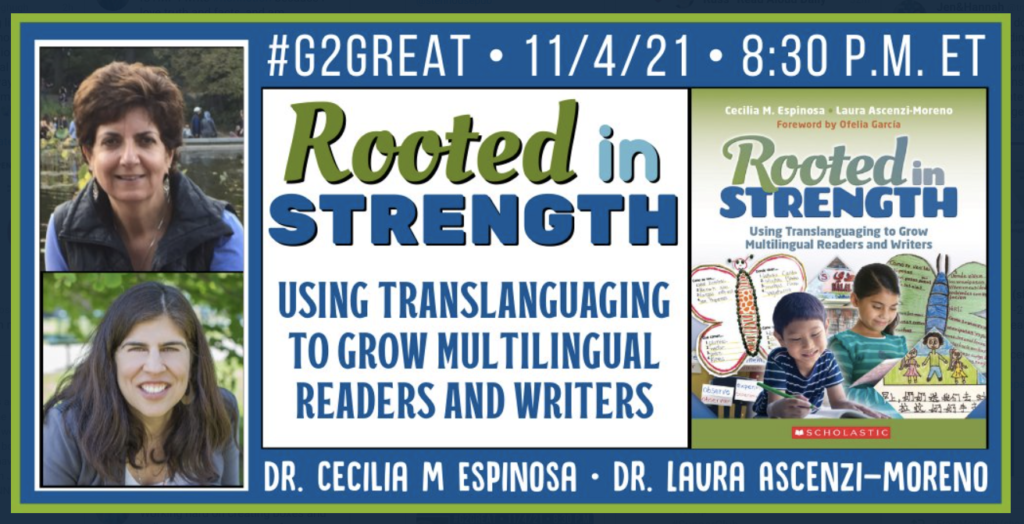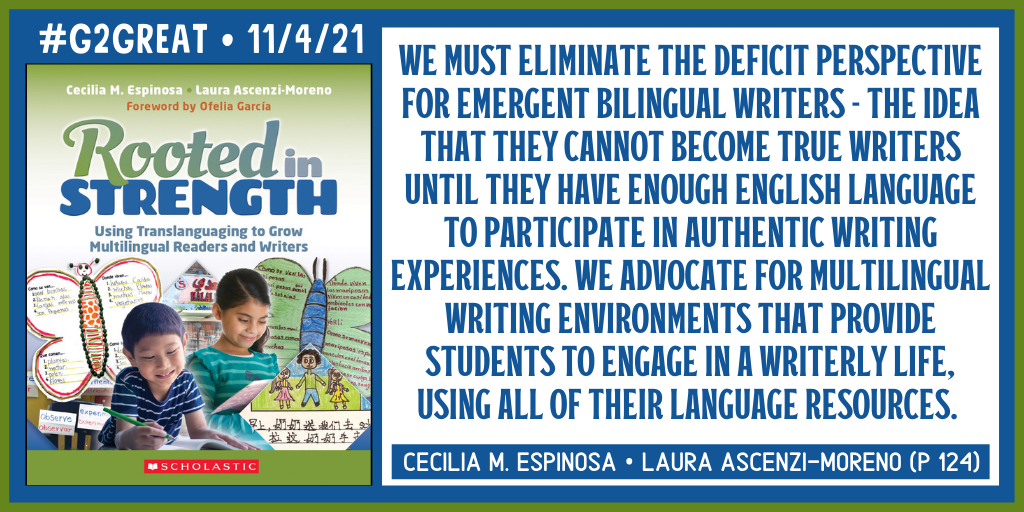By Fran McVeigh

On Thursday, November 4th, #G2Great hosted the first of a two part series on translanguaging. This chat featured Dr. Cecilia M Espinosa and Dr. Laura Ascenzi-Moreno and their book, Rooted in Strength: Using Translanguaging to Grow Multilingual Readers and Writers.
Words matter! Within this book you will see these words a lot: whole, grow, multilingual, translanguaging, strength and bilingual. (Word count from preview copy: 37, 39, 141, 220, 326, 695) The authors deliver with their focus on: multilingual, translanguaging, strength, and bilingual when discussing the needs of students at the emergent stage of learning an additional language. It will be important for you, the reader, to deepen your understanding through Cecilia and Laura’s viewpoint.
A translanguaging vision of reading posits that reading starts with the person. In other words, the multilingual person does not read in one language or the other, but rather brings his or her whole linguistic repertoire and social repertoire to the text. Reading cuts across named languages, modalities, and experiences.
Rooted in Strength: Using Translanguaging to Grow Multilingual Readers and Writers ( p.68)
This is a book about teaching for teachers that will help put bilingual students at the center of instruction. “You don’t have bilingual students in your classroom?” you say. Well, it is highly possible that you will eventually have students who identify as bilingual sometime in the future. Start planning now for your response. Your response to the ideas in this book will help you grow and practice seeing the “whole” in the multilingual folks in your own community. This book is bigger than just a “teaching book”. It’s an invitation to continue growing and learning both professionally and personally.
We asked Laura and Cecilia to respond to some questions in order to ensure that we included the author’s view of this text. I feel compelled to begin with this one which is usually the third and last one.
What is a message from the heart you would like for every teacher to keep in mind?
Teaching is an intellectual journey that pushes us to confront and renovate our understandings of students and their families. When we center instruction on emergent bilinguals as whole people, we do just that – we engage in the difficult, but rewarding work, of equity-based teaching. Every teacher can do this! It’s about having an open and curious heart and mind. Meaningful change in literacy instruction starts with the recognition that emergent bilinguals need to come to our classroom whole (with their languaging practices & socio-cultural histories). A translanguaging stance challenges us to embrace a radical departure from too long held deficit views about bilingualism. There is great power and potential for innovation and creativity when we build on the strengths of emergent bilingual students. This book is for all teachers who count emergent bilinguals as part of their classroom communities, those in general education, English as a new language, and bilingual education.
Many professional books are vying for your attention. Full disclosure, this is an infomercial. If you are seeking more because you have worked on individual skills or mentor texts, this book will give you ideas to consider, implement and reflect on their use as you encounter bigger views of instruction AND assessment for emergent multilingual students. You will be amazed how you can focus on and celebrate what students CAN do with an open and curious mind. The following quote is about writing, but it’s also true of reading. The deficit perspective has got to go!

A second author question that we use at #g2great …
What motivated you to write this book? What impact did you hope that it would have in the professional world?
This book emerges from our professional and personal experiences as educators of emergent bilinguals. First, we were frustrated that most of the professional literacy texts we read, always kept emergent bilinguals at the margins. We wanted to bring them to the center of all literacy instruction. We also wanted to bring a stance – translanguaging – which has become more known across educational circles – into active dialogue with teachers in a way that would be practical and inspiring.
We wrote this book knowing that for teachers, one of the greatest pleasures is to see their students deeply engaged in using reading and writing as tools for thinking, expressing, wondering and knowing. As new teachers we always looked for strategies to engage our emergent bilinguals – students who use two or more languages in their daily lives, in rich, thoughtful literacy practices. We also wrote this book with equity in mind – we know from experience that all pedagogy needs to be rooted in the fact that emergent bilinguals’ full participation as readers and writers is fundamental to any classroom where all students deeply engage in literacy.
Our hope with the book is that teachers see themselves as capable and excited to teach emergent bilinguals and that they understand how all students’ language practices are a key element to their success. We also want teachers to feel empowered through translanguaging pedagogy by understanding how they can shape literacy learning experiences through their deep knowledge of children.
Over 20 % of Americans are multilingual and are speaking more than one language at home according to the American Academy of Arts and Sciences. (Link) That compares with 56% of Europeans. Some experts propose that over half of the world’s population is multilingual. To be competitive in the world proficiency in another language or two may be required.
In the past many educators have been led to believe that teaching English as an additional language requires extensive training beyond a classroom teacher’s repertoire. Cecilia and Laura posit that it’s not about the specific skills of a teacher, but more about their own mindset, beliefs and actions.
The third and final question for Cecilia and Laura …
What are your BIG takeaways from your book that you hope teachers will embrace in their teaching practices?
First and foremost, literacy instruction for emergent bilinguals must be focused on the whole child. If we are truly committed to literacy instruction that is transformative and equitable the identities and full capacities of emergent bilinguals need to be recognized, incorporated and built upon as essential to all literacy instruction. It matters that we take a stance of strength and that we normalize our students and their families languaging practices.
Additionally, literacy and literacy instruction are never neutral. As teachers we have the power to privilege certain identities, histories, and language practices, while silencing others as substandard.
The theories we hold regarding how emergent bilingual children develop as readers and writers impact and inform our instruction in powerful ways. We need to create opportunities to value and to build on each and all of our students bi/multilingual resources.
In Conclusion …
As a result of reviewing Cecilia and Laura’s answers and the post this far, you have had more opportunities to interact with these words: “whole, grow, multilingual, translanguaging, strength and bilingual.” Maybe you are confident in your knowledge and are now at the curious stage. What might be some next steps? Being rooted in strength may be easy for educators with a growth mindset. But let’s shake the cobwebs off and dig, and dig, and dig. You might consider where and how to begin using this list as a guide.
- Be reflective. Take time to pause, to consider, to reflect, to review your status quo. Begin with your own knowledge of these words individually: “whole, grow, multilingual, translanguaging, strength and bilingual”.
- Consider the impact of your increased knowledge for students in your classroom, building, district, and community.
- Place one student at the center and consider the whole of your knowledge about what that child can do.
- Study translanguaging principles (Chapter 1). Collect some translanguaging models with a range of formats. How will translanguaging solidify the strengths of the student from #3 above?
- Study the possibilities for a multilingual learning environment (Chapter 2). How will the student from #3 thrive in this environment?
- Deepen your understanding of reading and writing assessments that are always double jeopardy for language learners (Chapters 6 and 10). What new information would be available about the student in #3?
- Study reading and writing (Chapters 3-5 and 7-9). How is your new learning increasing the effectiveness of the student you are planning for from #3?
Grab a friend as a thought partner and get started! Your students will benefit!
Additional Resources
Scholastic Blog Post about Rooted in Strength: https://oomscholasticblog.com/post/rooted-strength-debut-title-cecilia-m-espinosa-and-laura-ascenzi-moreno-explores-how
Interview with Ernest Morell: http://teacher.scholastic.com/education/reachteach/reachteachlanding_cecilia_m_espinosa_and_laura_ascenzi_moreno.html
Bring me a Book Foundation Toolkits: https://www.bringmeabook.org/advocates/laura-ascenzi-moreno/
Websites:
Cecilia M. Espinosa
ceciliamespinosa.wordpress.com/
Laura Ascenzi-Moreno